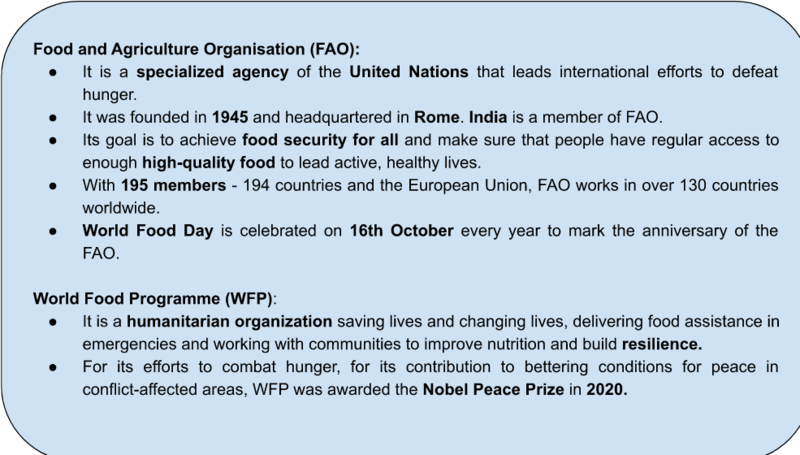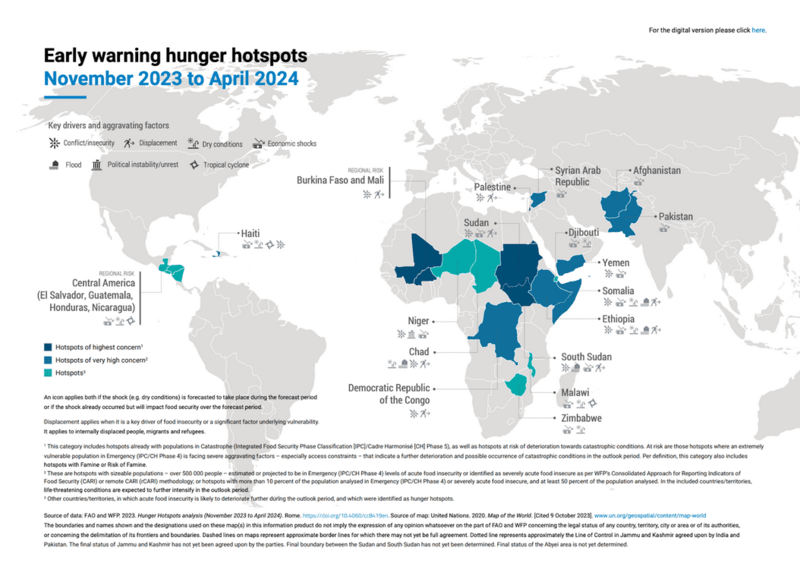GS Paper II
News Excerpt:
The Food and Agriculture Organization of the United Nations (FAO) and the World Food Programme (WFP) have released the report “Hunger Hotspots”.
- It predicts a worsening of food insecurity in 18 hunger hotspots, including 22 countries, from November 2023 to April 2024.

Key findings of the report:
- In the hunger hotspots, parts of the population will likely face a significant deterioration of already high levels of acute food insecurity, putting lives and livelihoods at risk.
- Highest concerns - hotspots with catastrophic conditions:
- Burkina Faso, Mali, South Sudan, and Sudan are among the countries with the highest concern level due to their populations facing starvation or risk of catastrophic conditions.
- Palestine was added due to the escalating conflict in October 2023, requiring urgent attention due to critical food insecurity and aggravating factors.
- Very High concerns - hotspots with deteriorating critical conditions:
- Afghanistan, the Democratic Republic of the Congo (DRC), Ethiopia, Haiti, Pakistan, Somalia, the Syrian Arab Republic, and Yemen are high-risk hotspots.
- They have high levels of acute food insecurity and worsening drivers expected to intensify life-threatening conditions in the coming months.
- Since the May 2023 edition, Chad, Djibouti, Niger, Palestine, and Zimbabwe have been added to the list of hunger hotspot countries/territories.


Food insecurity drivers:
- Organised violence and conflict risks:
- Armed violence, mainly civilian targeting, is likely to continue driving global displacement. The Gaza Strip's hostilities are expected to intensify humanitarian issues, with potential regional implications.
- Instability and violence in the Sahel region, including recent coups in Burkina Faso, Mali, and Niger, are also escalating. The withdrawal of peacekeeping missions from Mali, the Democratic Republic of the Congo, and Somalia could amplify security voids, allowing increased Non-State Armed Group (NSAG) activities and attacks against civilians.
- Insecurity and conflicts are also expected to exacerbate food access, leading to displacement, market disruption, and abandoned cultivated areas, further deepening food crises.
- Economic risks:
- The global economic outlook for 2024 is sluggish, with tight monetary policies following a decline in 2023.
- International food prices remain high but are expected to rise due to oil price dynamics and El Nino conditions.
- Low- and middle-income countries face challenges in importing goods, with high commodity prices, weak currencies, and depleted foreign exchange reserves.
- Limited economic access and reduced donor support further exacerbate the situation.
- Natural hazard risks:
- Hunger hotspots like Afghanistan, Haiti, Palestine, Somalia, the Syrian Arab Republic, Yemen, Malawi, Uganda, and Cox's Bazar face ongoing reductions and gaps in emergency agriculture, food, and livelihood assistance.
- Weather extremes like heavy rains, tropical storms, cyclones, flooding, drought, and climate variability drive acute food insecurity.
- El Nino, which reached its peak activity in September 2023, is expected to persist in the coming six months, negatively impacting regions in Southeast Asia and Latin America.
Way forward:
- The report provides recommendations on priorities for:
-
- Anticipatory action – short-term protective interventions to be implemented before new humanitarian needs materialise.
- Emergency response – actions to address existing and emerging humanitarian needs.
- Humanitarian intervention in terms of financial resources and capacity generation is of vital importance in regions where severe hunger is likely to develop to save lives, preserve livelihoods, and avert starvation and death.
- Weather forecasts, technical know-how and their effects on output need to be continuously monitored. To save livelihoods and expand access to food, all 18 hunger hotspots need immediate and increased support.
Mains PYQs
Q. How far do you agree with the view that the focus on the lack of availability of food as the main cause of hunger takes the attention away from ineffective human development policies in India? (UPSC 2018)
Q. There is a growing divergence in the relationship between poverty and hunger in India. The shrinking of social expenditure by the government is forcing the poor to spend more on non-food essential items squeezing their food budget. Elucidate. (UPSC 2019)
